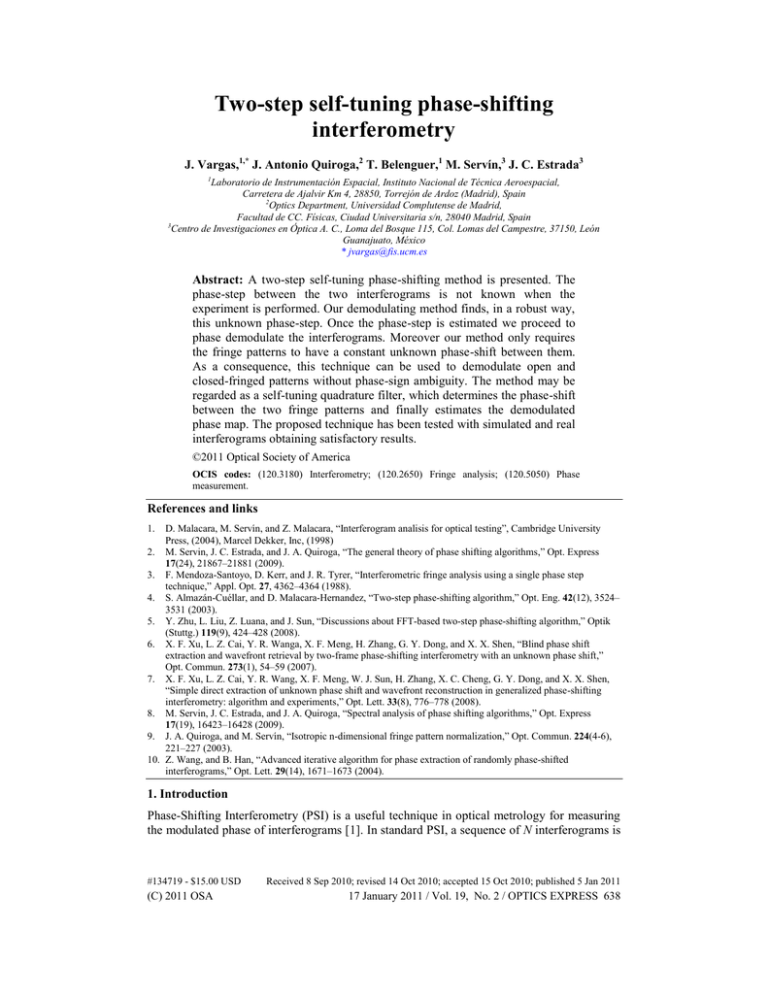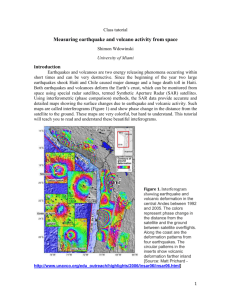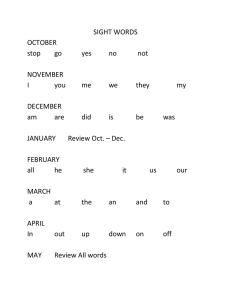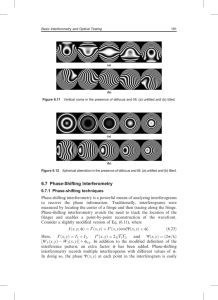Two-step self-tuning phase-shifting interferometry
advertisement

Two-step self-tuning phase-shifting interferometry J. Vargas,1,* J. Antonio Quiroga,2 T. Belenguer,1 M. Servín,3 J. C. Estrada3 1 Laboratorio de Instrumentación Espacial, Instituto Nacional de Técnica Aeroespacial, Carretera de Ajalvir Km 4, 28850, Torrejón de Ardoz (Madrid), Spain 2 Optics Department, Universidad Complutense de Madrid, Facultad de CC. Físicas, Ciudad Universitaria s/n, 28040 Madrid, Spain 3 Centro de Investigaciones en Óptica A. C., Loma del Bosque 115, Col. Lomas del Campestre, 37150, León Guanajuato, México * jvargas@fis.ucm.es Abstract: A two-step self-tuning phase-shifting method is presented. The phase-step between the two interferograms is not known when the experiment is performed. Our demodulating method finds, in a robust way, this unknown phase-step. Once the phase-step is estimated we proceed to phase demodulate the interferograms. Moreover our method only requires the fringe patterns to have a constant unknown phase-shift between them. As a consequence, this technique can be used to demodulate open and closed-fringed patterns without phase-sign ambiguity. The method may be regarded as a self-tuning quadrature filter, which determines the phase-shift between the two fringe patterns and finally estimates the demodulated phase map. The proposed technique has been tested with simulated and real interferograms obtaining satisfactory results. ©2011 Optical Society of America OCIS codes: (120.3180) Interferometry; (120.2650) Fringe analysis; (120.5050) Phase measurement. References and links D. Malacara, M. Servín, and Z. Malacara, “Interferogram analisis for optical testing”, Cambridge University Press, (2004), Marcel Dekker, Inc, (1998) 2. M. Servin, J. C. Estrada, and J. A. Quiroga, “The general theory of phase shifting algorithms,” Opt. Express 17(24), 21867–21881 (2009). 3. F. Mendoza-Santoyo, D. Kerr, and J. R. Tyrer, “Interferometric fringe analysis using a single phase step technique,” Appl. Opt. 27, 4362–4364 (1988). 4. S. Almazán-Cuéllar, and D. Malacara-Hernandez, “Two-step phase-shifting algorithm,” Opt. Eng. 42(12), 3524– 3531 (2003). 5. Y. Zhu, L. Liu, Z. Luana, and J. Sun, “Discussions about FFT-based two-step phase-shifting algorithm,” Optik (Stuttg.) 119(9), 424–428 (2008). 6. X. F. Xu, L. Z. Cai, Y. R. Wanga, X. F. Meng, H. Zhang, G. Y. Dong, and X. X. Shen, “Blind phase shift extraction and wavefront retrieval by two-frame phase-shifting interferometry with an unknown phase shift,” Opt. Commun. 273(1), 54–59 (2007). 7. X. F. Xu, L. Z. Cai, Y. R. Wang, X. F. Meng, W. J. Sun, H. Zhang, X. C. Cheng, G. Y. Dong, and X. X. Shen, “Simple direct extraction of unknown phase shift and wavefront reconstruction in generalized phase-shifting interferometry: algorithm and experiments,” Opt. Lett. 33(8), 776–778 (2008). 8. M. Servin, J. C. Estrada, and J. A. Quiroga, “Spectral analysis of phase shifting algorithms,” Opt. Express 17(19), 16423–16428 (2009). 9. J. A. Quiroga, and M. Servín, “Isotropic n-dimensional fringe pattern normalization,” Opt. Commun. 224(4-6), 221–227 (2003). 10. Z. Wang, and B. Han, “Advanced iterative algorithm for phase extraction of randomly phase-shifted interferograms,” Opt. Lett. 29(14), 1671–1673 (2004). 1. 1. Introduction Phase-Shifting Interferometry (PSI) is a useful technique in optical metrology for measuring the modulated phase of interferograms [1]. In standard PSI, a sequence of N interferograms is #134719 - $15.00 USD (C) 2011 OSA Received 8 Sep 2010; revised 14 Oct 2010; accepted 15 Oct 2010; published 5 Jan 2011 17 January 2011 / Vol. 19, No. 2 / OPTICS EXPRESS 638 obtained having a known temporal carrier. Usually a minimum of three phase-shifted interferograms are need to retrieve the phase. Other phase-shifting methods have been reported as the four-step, five-step or the least-squares algorithm, for example. A good general overview of the phase-shifting algorithms can be found in [2]. The use of fewer interferograms in PSI simplifies the computation process and the processing speed. Moreover, it increases the robustness against uncontrolled mechanical vibrations, air turbulence or temperature changes in the measuring system. In the case of open-fringe interferograms, there have been proposed many single-frame demodulating methods but in the case of closedfringes, it is needed at least-two frames to solve the local phase-sign ambiguity. Note that a global sign ambiguity in the retrieved phase is irrelevant. In the past there have been reported works about phase reconstruction with only twoframes. Ref [3]. proposes a method for demodulating two interferograms with a known phase shifting of between them. In Refs [4,5] are proposed two-step phase-shifting algorithms 2 that don’t need knowing the phase step between interferograms. The main drawbacks of [4,5] are that the methods don’t work if the phase-shift is close to π radians and in the case of interferograms with low spatial frequency fringes. Ref [6]. shows an alternative approach that uses the least-squares method to extract the unknown phase-shift between two interferograms and then obtain the phase distribution. This method requires many iterations to converge (typically 17 iterations) and is sensitive to noise as only two frames are used. More recently, Ref [7]. shows a method to extract the arbitrary unknown phase-shift between two interferograms and then reconstruct the complex object wave without iteration process. This technique only can be used in amplitude division interferometry as it needs to measure, additionally with the two phase-shifted frames, the intensity of the reference beam. On the other hand, this method requires the reference intensity to be constant along the full aperture that can be a non realistic case when we deal with real interferograms. In addition, the method assumes that the intensity of the reference beam is greater than the maximum of the object beam that can be problematic in some cases. In this work, we propose a self-tuning two-step phase-shifting algorithm that doesn’t need to known the phase-step between interferograms. This phase-step can be any value between [π, π]. The proposed method doesn’t need to iterate, it can be used to any kind of fringe pattern as it doesn’t need to measure the intensity of the reference beam and no suppositions are made to the fringe spatial frequency, background and modulation maps. The structure of the paper is as follow: in the next section we introduce our tunable twostep phase-shifting algorithm to determine the temporal carrier. After this, the modulated phase is obtained. In sections 3 and 4 the simulation and experimental results are given. In the simulation results section we have applied the proposed method to two simulations, one with open and other with closed fringes. Finally, in section 5 some conclusions are drawn. 2. Proposed method In PSI, a discrete temporal interferogram can be described using the following expression, g x, y, t a x, y b x, y cos x, y 0t (1) where a x, y is the background illumination, b x, y and x, y are the modulation and phase maps, and 0 is the temporal carrier frequency. The integer index t denotes the tth interferogram obtained at time t. In our case t = [0, 1]. For simplicity in the following we will drop the spatial dependence. Expression (1) can be rewritten as follow, g t a #134719 - $15.00 USD (C) 2011 OSA b i x , y 0t i x , y 0 t e e 2 (2) Received 8 Sep 2010; revised 14 Oct 2010; accepted 15 Oct 2010; published 5 Jan 2011 17 January 2011 / Vol. 19, No. 2 / OPTICS EXPRESS 639 The Fourier transform of expression (2) is, G a b 0 ei 0 e i 2 (3) where is the Dirac delta function. In order to obtain the desired phase map, we can define a complex quadrature filter with frequency response H and with the following requirements H 0 0 , H 0 0 and H 0 0 [2]. The filtered complex function, G , is obtained by multiplication of G and H as, G b H 0 0 ei 2 (4) Performing the inverse Fourier transform of expression (4) we obtain the complex intensity function as, g t b H 0 ei eio t 2 (5) Finally, the phase and modulation maps are acquired evaluating g t at t = 0 obtaining the angle and the norm of g 0 respectively as, Im g 0 tan 1 Re g 0 (6) and, b H (7) 2 The mathematical analysis shown above assumes that the temporal frequency 0 is known. On the other hand, as we said, in order to built a practical quadrature filter that achieves the requirement H 0 0 and H 0 0 , it is necessary at least three temporal g 0 interferograms [1]. In a self-tuning phase-shifting algorithm the temporal frequency 0 is unknown and it is introduced as a free parameter of the algorithm [8]. The algorithm has to determine this temporal frequency by its own. As we only have available two interferograms, it is not possible to obtain a quadrature filter that achieves H 0 0 and therefore the filter will not subtract the interferograms background. Consequently, a necessary previous step is to eliminate the background component in expression (1). One possibility is to normalize the interferograms. If the interferograms are normalized, the background is filtered-out and the zero-frequency filter condition, H 0 0 is relaxed. In this case, the quadrature filter requirements are only H 0 0 and H 0 0 . The normalized version of expression (1) is g x, y, t cos x, y 0t (8) The normalizing method used in this work has been reported in [9]. The method shown in [9] consists in employing an isotropic operator. This method is robust to wide-band fringe spatial frequencies, obtaining good solutions. #134719 - $15.00 USD (C) 2011 OSA Received 8 Sep 2010; revised 14 Oct 2010; accepted 15 Oct 2010; published 5 Jan 2011 17 January 2011 / Vol. 19, No. 2 / OPTICS EXPRESS 640 The proposed self-tuning phase-shifting algorithm is based on analyzing g 0 2 parameter when a detuning error exists. This detuning error appears when the quadrature filter H is tuned in a temporal frequency f different to the assumed one 0 [2]. Figure 1 shows a scheme of a H filter when there is non detuning error (Fig. 1 (a)) and when there is (Fig. 1 (b)). In Fig. 1(a) it is shown the case where f coincides with 0 and there is non detuning error. In Fig. 1(b) it is shown the case where f 0 and therefore, H 0 0 and H 0 0 . In this case, a detuning error does exist and expression (4) is not longer valid. Fig. 1. Scheme of the detuning error that appears when coincides with 0 f 0 . and there is non detuning error. (b) In this case (a) In this case f 0 f and there is non-detuning This expression is rewritten in the case of f 0 as, G 1 H 0 0 ei H 0 0 e i 2 (9) and the intensity complex function is given as, g t 1 H 0 ei eio t H 0 e i e io t 2 (10) In this case g 0 is affected by a detuning error and it is given by, g 0 2 #134719 - $15.00 USD (C) 2011 OSA 1 A 0 B 0 C 0 cos 2 D 0 sin[2 ] 4 (11) Received 8 Sep 2010; revised 14 Oct 2010; accepted 15 Oct 2010; published 5 Jan 2011 17 January 2011 / Vol. 19, No. 2 / OPTICS EXPRESS 641 with, A 0 H 0 , B 0 H 0 , 2 2 C 0 Re H 0 H 0 and D 0 Im H 0 H 0 . The standard deviation σ of (11) is given by, 2 1 g 0 C 0 cos 2 D 0 sin[2 ] 4 (12) From a practical point of view, the standard deviation is obtained from g 0 map as, 2 2 g x, y , 0 g x, y, 0 1 M x y 2 gm 2 (13) where, M is the number of pixels in the map and g m is the mean of g x, y,0 . Note that in 2 (13) we have introduced the spatial dependence of g for the sake of clarify. Additionally, g 0 can be obtained from the convolution product between g t and h(t ) as 1 H ( )eit d . In expression (12) there is no 2 terms because they are constants and the standard g 0 g t h t dt , where h(t ) contribution of A 0 and B 0 deviation is invariant under translation changes. If f 0 , B 0 0 , C 0 0 , 2 2 D 0 0 and g 0 equals to zero in expression (12). In any other case, g 0 obtains a positive value different of zero. Using this property, it is possible to construct a filter H that is tuned at different temporal frequencies f and look for the temporal frequency which returns a minimum value in g 0 . Using this filter tuned at 0 , the phase map is determined using expressions (4) to (6). In this work, in order to accurately obtaining the temporal carrier 0 by the proposed self2 tuning method explained above, it is very important to use a quadrature filter H with a very sharp frequency response near f . This sharp response allows one to obtain a clear and 2 narrow minimum in g 0 and therefore determining accurately 0 . The quadrature filter that we have used is [2] f i / 2 H ( ) sin e 2 (14) And its corresponding temporal impulse response is given by, h(t ) 1 2 H ( )e it d 1 i f / 2 i / 2 e t 1 e f t 2i (15) In summary, the proposed two-step self-tuning phase-shifting method is based on three steps. In a first step, the two fringe patterns are normalized. Next the quadrature filter H () , shown in expression (14) is tuned sequentially at a predetermined discrete set of frequencies within 2 0, 2 . The standard deviation g 0 is computed for each frequency of that particular #134719 - $15.00 USD (C) 2011 OSA Received 8 Sep 2010; revised 14 Oct 2010; accepted 15 Oct 2010; published 5 Jan 2011 17 January 2011 / Vol. 19, No. 2 / OPTICS EXPRESS 642 set. Finally, the tuning frequency that gives a minimum response on g 0 is chosen. Once an estimate of 0 is found, the demodulated wrapped phase map is obtained. This method uses exhaustive search, thus, it is as fast as the size of the discrete searching tuning frequency set. This is not a serious concern given that the computational cost of exploring a sampled one-dimensional space , exhaustively with, say 600 samples, is 2 not high. 3. Simulations In order to show the performance of the proposed method, we have tested it with a simulation using closed-fringe interferograms. The utility of this method has special interest in the case of closed-fringe interferograms as two-frames are the minimum number of interferograms to reconstruct the phase without local phase-sign ambiguity. In Fig. 2 are shown the two fringe patterns of the simulation. As can be seen from Fig. 2, the interferograms have a size of 411x411 pixels2. The background and modulation maps of the fringe patterns are equal to zero and 125 a.u (arbitrary units) in every pixel. The noise is Gaussian with zero mean and a variance of 13 a.u. The temporal frequency 0 is equals to 1.2 rad. Fig. 2. Two fringe patterns used in the first simulation In Fig. 3, it is shown the plot between the standard deviation of the modulation map 2 g 0 and the different temporal frequencies f . The discrete searching tuning frequency set is composed by 600 frequencies equally spaced between [0, 2 ] and the processing time is of 5 s using a 1.6 GHz laptop and MATLAB. The detected minimum corresponds to 0 = 1.203 rad and it is marked in the figure with a red square. #134719 - $15.00 USD (C) 2011 OSA Received 8 Sep 2010; revised 14 Oct 2010; accepted 15 Oct 2010; published 5 Jan 2011 17 January 2011 / Vol. 19, No. 2 / OPTICS EXPRESS 643 Fig. 3. Plot between the standard deviation of the modulation map 2 g 0 and the different temporal frequencies f obtained in the first simulation Observe in Fig. 3 that are obtained two minimums, one at 0 and other at 2 0 . Note that it is irrelevant to select one or the other as the only consequence will be a global phasesign change in the reconstructed phase . In Fig. 4, it is shown the obtained wrapped phase. Finally, in Fig. 5 are shown the reconstructed phase and the computed error between actual and obtained phases. The rms (root-mean-square) error of the difference between the actual and measured phases is 0.08 rad. Fig. 4. Obtained wrapped phase in the first simulation #134719 - $15.00 USD (C) 2011 OSA Received 8 Sep 2010; revised 14 Oct 2010; accepted 15 Oct 2010; published 5 Jan 2011 17 January 2011 / Vol. 19, No. 2 / OPTICS EXPRESS 644 Fig. 5. Reconstructed phase (a) and computed error between actual and computed phases (b) In order to show the performance of the two-step self-tuning algorithm to noisy interferograms, we have obtained for different signal to noise ratios the computed temporal frequency ̂ 0 , the absolute difference between the actual and computed temporal frequencies 0 ˆ 0 , the rms error between the actual and computed phase maps and the processing times. The computed phase map is retrieved by interferograms without noise in order to show the detuning error caused by the mismatch between the actual and obtained temporal frequencies. In Table 1, the first row corresponds to the different signal to noise ratios that quantify how much the phase has been corrupted by noise. As can be seen from Table 1, the proposed two-step self-tuning algorithm gives appropriate results even in the case of interferograms with high noise. Table 1. Obtained temporal frequencies ̂ 0 , absolute difference between the actual and computed temporal frequencies 0 ˆ 0 , rms errors obtained between the actual and computed phase maps (with the phase maps retrieved by interferograms without noise and from the computed temporal frequencies) and processing times for different signal to noise ratios 0 15 30 45 60 75 90 100 0 (rad) 0 ˆ 0 (rad) 1.20 1.21 1.22 1.450 1.35 1.41 1.46 1.48 4.8e-4 1.2e-2 2.4e-2 1.682 0.15 0.21 0.26 0.28 rms (a.u) 2.4e-3 6.0e-3 1.0e-2 0.0424 5.8e-2 8.1e-2 9.9e-2 0.10 time (s) 4.9 5.0 5.0 5.1 4.9 5.0 4.9 5.0 % 4. Experimental results We have applied the proposed algorithm to real interferograms. In order to check the obtained results, we have compared the retrieved phase from our method with the phase obtained from 10 phase-shifted interferograms, and using the least-squares phase demodulation method [10]. In Fig. 6 are shown the two interferograms used in our approach and the normalized version of them. #134719 - $15.00 USD (C) 2011 OSA Received 8 Sep 2010; revised 14 Oct 2010; accepted 15 Oct 2010; published 5 Jan 2011 17 January 2011 / Vol. 19, No. 2 / OPTICS EXPRESS 645 Fig. 6. (a), (b) Real Interferograms (c), (d) Resultant interferograms after the normalization process. In Fig. 7(a) and 7(b) are shown the acquired wrapped phase obtained from our method and with the least-squares method using 10 interferograms. The processing times using the proposed method and the least-squares method are 12 s and 30 s respectively. #134719 - $15.00 USD (C) 2011 OSA Received 8 Sep 2010; revised 14 Oct 2010; accepted 15 Oct 2010; published 5 Jan 2011 17 January 2011 / Vol. 19, No. 2 / OPTICS EXPRESS 646 Fig. 7. Computed wrapped phase obtained with the two-step proposed method (b) Wrapped phase obtained by the least-squares demodulation method using 10 interferograms As can be seen from Figs. 7(a) and 7(b) both wrapped phases are similar. In Figs. 8(a) and 8(b) are shown the reconstructed phases with both methods and finally in Fig. 9 it is shown the difference between the reconstructed phases. Fig. 8. Reconstructed phases with the proposed method (a) and with the least-squares method (b). #134719 - $15.00 USD (C) 2011 OSA Received 8 Sep 2010; revised 14 Oct 2010; accepted 15 Oct 2010; published 5 Jan 2011 17 January 2011 / Vol. 19, No. 2 / OPTICS EXPRESS 647 Fig. 9. Difference between the reconstructed phases shown in Fig. 12 using the proposed method and the least-squares method As can be seen from Fig. 9 there is a good agreement between both measures. The rms (root-mean-square) error of the difference between both reconstructed phases is 0.3 rad. On the other hand, the temporal frequency between interferograms obtained by the proposed and the least-squares methods is 0 = 0.7 rad and 0 = 0.85 rad respectively. 5. Conclusions In this work, we have proposed a self-tuning two-step phase-shifting algorithm that doesn’t need to known the phase-step between interferograms. This phase-step can be any value between [-π, π]. The proposed method doesn’t need to iterate, however our technique uses an exhaustive search strategy. This method can be used with any kind of fringe pattern as it doesn’t need to measure the intensity of the reference beam and no suppositions are made to the fringe spatial frequencies, background and modulation maps. We have tested the proposed method to simulated and real interferograms, and we have shown a very good performance of the proposed method. #134719 - $15.00 USD (C) 2011 OSA Received 8 Sep 2010; revised 14 Oct 2010; accepted 15 Oct 2010; published 5 Jan 2011 17 January 2011 / Vol. 19, No. 2 / OPTICS EXPRESS 648





